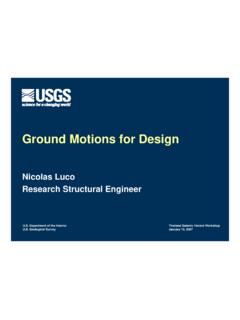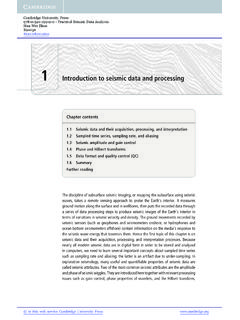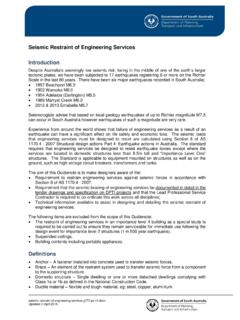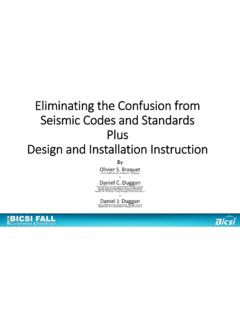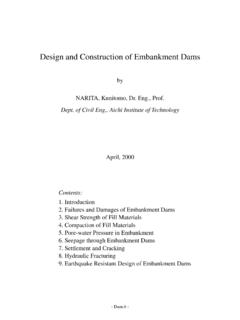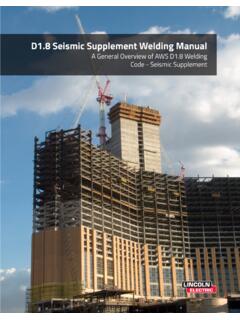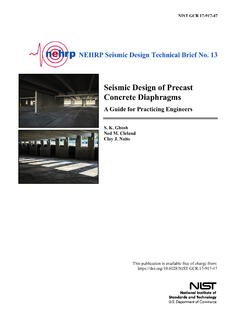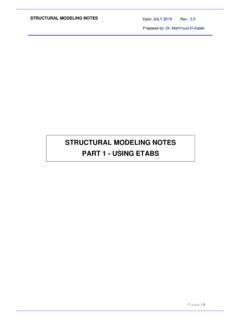Transcription of Basic Seismology: Some Theory and Observations
1 Basic Seismology: Basic Seismology: Some Theory and ObservationsSome Theory and Observations Earthquakes occur as slip across a plane in the occur as slip across a plane in the earth. Any local deformation in an elastic solid stressesAny local deformation in an elastic solid stressesnearby material, which deforms in turn, stressingnearby material, which deforms in turn, stressingnearby material, and so on nearby material, and so on .. The local stresses and strains are linked by theThe local stresses and strains are linked by theconstitutive properties of the properties of the material. Consideration of Basic relationships between the forcesConsideration of Basic relationships between the forcesand deformations in the material ( , Newtonand deformations in the material ( , Newton s Law)s Law)leads to equations describing the propagation ofleads to equations describing the propagation ofseismic waves away from the energy waves away from the energy source.
2 These propagating waves cause most of the damage inThese propagating waves cause most of the damage introduction To Seismology, Earthquakes, and Earth Structure by Stein & Wysession, Blackwell PublishingThe seismic wavefield is generated at the source and modified by propagation throughthe earth medium where is reflected, transmitted, focused, scattered, and attenuated. Ourknowledge of earthquake processes and earth structure comes from both forwardmodeling and inversion of earthquake travel-time and ground-shaking data . Shaking at a given site, say one of engineeringShaking at a given site, say one of engineeringinterest, is controlled by:interest, is controlled by: The amount, pattern, direction, and timing of slip on theThe amount, pattern, direction, and timing of slip on thefaultfault The distance of the site from the faultThe distance of the site from the fault The types of geologic structures and materials along theThe types of geologic structures and materials along thewave path ( , waves can be focused by geologicwave path ( , waves can be focused by geologiccontrasts, absorbed as they pass through materials withcontrasts, absorbed as they pass through materials withinefficient transmission properties, etc.))
3 Inefficient transmission properties, etc.) The structure and physical properties of geologic materialsThe structure and physical properties of geologic materialsat the site ( , shaking can be amplified or diminished inat the site ( , shaking can be amplified or diminished inan alluvial basin in complex ways depending on itsan alluvial basin in complex ways depending on itsamplitude and frequency)amplitude and frequency)Development of the seismic waveequation begins with consideration ofthe forces acting on an infinitesimalplane within a homogeneous elasticmedium in static (stress) and deformation (strain)at a point in a general elastic solid arerelated by a (81-component) fourth-order constitutive tensor. If the physicalproperties of the medium are direction-independent (isotropic), a good first-order approximation for the earth, thenumber of independent elasticparameters reduces to two.
4 The P-waveand S-wave seismic velocities at eachpoint in the medium can be determinedfrom these two elastic parameters andthe density. introduction To Seismology by P. Shearer, Cambridge University PressNow consider an infinitesimal cubeembedded within a homogeneous,isotropic elastic medium. If the stressfield is homogeneous there is no netforce on the cube, but spatial gradients inthe stress field generate net forces. Thecube is now in motion, and we useNewton s Law to derive the equation can use relationships between stressand strain to express stress gradients interms of displacements. These equationscan be used directly in finite-differenceequations. Otherwise, we can use vectorcalculus to derive simpler waveequations for the P-wave and S-wavefields. introduction To Seismology by P. Shearer, Cambridge University Press introduction To Seismology by P.
5 Shearer, Cambridge University PressReal seismic wavefronts in the earth are curved, but a plane wave canbe a useful concept. (For example, a spherical wave can be expressedas a sum of plane waves.) This is the general form of a plane wave inthe frequency domain. Displacement varies in time and space (x-dimension only in this case), expressed as an amplitude term times aharmonic function of frequency and slowness, s, or wavenumber, k. Aspherical wave has a similar functional form with an additionaldistance decay factor of 1/r. introduction To Seismology by P. Shearer, Cambridge University PressSolutions of the seismic wave equation forSolutions of the seismic wave equation forcompressionalcompressional- (P-) and shear (S-) waves in a- (P-) and shear (S-) waves in auniform whole space are readily found, but this caseuniform whole space are readily found, but this caseis not very interesting to a seismologist who is tryingis not very interesting to a seismologist who is tryingto model seismic waves in a realistic model seismic waves in a realistic The Seismic Wave EquationInteresting (non-trivial) earth models that we mightInteresting (non-trivial)
6 Earth models that we mightwish to use contain gradients in the physicalwish to use contain gradients in the physicalparameters that control wave propagation, but theseparameters that control wave propagation, but thesefactors severely complicate solutions of the wavefactors severely complicate solutions of the waveequation. Several approaches have been devised thatequation. Several approaches have been devised thatallow us to ignore the gradient terms and find anallow us to ignore the gradient terms and find anapproximate solution, yet still include some realisticapproximate solution, yet still include some realisticstructure in the in the model. introduction To Seismology by P. Shearer, Cambridge University PressHomogeneous Layer MethodsHomogeneous Layer Methods To first order, seismic velocity is a function only ofTo first order, seismic velocity is a function only ofdepth in the earth; the earth can be modeled as adepth in the earth; the earth can be modeled as aseries of homogeneous layers in which the gradientseries of homogeneous layers in which the gradientterms vanish.
7 Wave propagation inside each layer is simple; it onlyWave propagation inside each layer is simple; it onlyremains to keep track of interactions of the wave fieldremains to keep track of interactions of the wave field(reflection and transmission) at the layer boundaries(reflection and transmission) at the layer boundaries(this is a simpler problem).(this is a simpler problem). A continuous 1-dimensional velocity gradient can beA continuous 1-dimensional velocity gradient can bemodeled by simply increasing the number of by simply increasing the number of MethodsRay Methods The importance of the gradient terms varies asThe importance of the gradient terms varies as1/frequency, so they become1/frequency, so they become vanishingly vanishingly small forsmall forhigh-frequency waves. Thus, rays traced through ahigh-frequency waves.
8 Thus, rays traced through amodel with continuous physical properties accuratelymodel with continuous physical properties accuratelydescribe the high-frequency wave the high-frequency wave TheoryRay Theory A high-frequency approximationA high-frequency approximation Simple to program, computationallySimple to program, computationallyefficient, and easy to generalize to 3-efficient, and easy to generalize to 3-dimensional earth modelsdimensional earth models Good for: modeling seismic phaseGood for: modeling seismic phasearrival times, earthquake locationarrival times, earthquake locationalgorithms, body-wave focalalgorithms, body-wave focalmechanism determinations, inversionsmechanism determinations, inversionsfor velocity structurefor velocity structure Not very good for: amplitudesNot very good for: amplitudesbecause it is a high-frequencybecause it is a high-frequencyapproximationapproximation introduction To Seismology by P.
9 Shearer, Cambridge University PressA seismic version of Snell s Law fromoptics can be used to track raygeometry through inhomogeneousmaterials. Rays can be traced throughregions with continuous velocitygradients. introduction To Seismology by P. Shearer, Cambridge University PressRay tracing results are often summarized as travel-time curves: travel-time as a function of distance from the ray source. Each point on thecurve represents a different ray path through the model. This exampleshows a case with a steep velocity increase. Locally a flat earth modelcan be used; for global studies we use a spherical earth model. introduction To Seismology by P. Shearer, Cambridge University PressRays are a particularly useful tool forstudying global body-waves. Thismodel of the earth shows the mantle,liquid outer core, and solid inner codes for whole-earth phases:P: P-wave in mantleK: P-wave in outer coreI: P-wave in inner coreS: S-wave in mantleJ: S-wave in inner corec: reflection off core-mantle boundaryi: reflection off inner-core boundary introduction To Seismology by P.
10 Shearer, Cambridge University PressSeismograms are records ofearthquake ground shaking vs seismographs record threeorthogonal components of groundshaking: one vertical component andtwo horizontal components. Groundshaking in any direction can becomputed by combining these threecomponents. To understand earthstructure and earthquake processeswe need records of ground shakingfrom a wide range of earthquakemagnitudes at a wide range ofdistances. introduction To Seismology by P. Shearer, Cambridge University Press introduction To Seismology by P. Shearer, Cambridge University Press introduction To Seismology by P. Shearer, Cambridge University Press introduction To Seismology by P. Shearer, Cambridge University Press introduction To Seismology by P. Shearer, Cambridge University Press introduction To Seismology, Earthquakes, and Earth Structure by Stein & Wysession, Blackwell PublishingTypical strategy:1)Find an average 1-D velocity-depth function.


